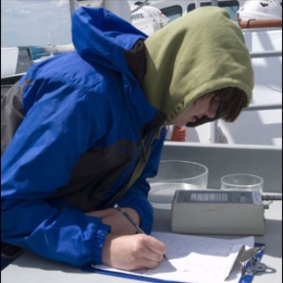Eight students will be presenting the summer work at the Ocean Sciences Meeting in March 2022!
Caroline Baumgartner, Muhlenberg College
Class Year:
2008Mentor:
Cindy Palinkas, Ph.D.Project Title:
Sediment Grain Size in Current and Historical SAV Beds of the Chesapeake
Abstract:
The drastic decline of seagrasses and other submerged aquatic vegetation (SAV) in the Chesapeake Bay over the last century is a major concern and has sparked both research and restoration efforts to combat the problem. Due to previous studies, distribution is known to be heavily affected by water quality factors such as light availability, salinity, temperature and depth. Sediment type, although secondary, also seems to be a contributing factor. In this study, pushcores were taken at two sites with stable SAV beds, Trippe Bay and Crab Alley Bay, and at two sites that had previously contained historical beds, Casson Point and Herring Bay. Samples were then separated at 0.5-1 cm depth increments and each interval wet sieved at 64 μm and dried to determine the mud and sand portions. Dry sieving was used to determine the particle size distribution within the sand component for each interval. Both stable sites were found to have well-sorted surface sediment with the majority of particles falling between 106-150 μm. The historical site Casson Point did have a slight fining trend, while Herring Bay remained constant. The grain-size profiles for the stable sites Trippe Bay and Crab Alley Bay were also relatively constant (except for the fine top layer which may have been deposited because of the current-slowing beds). Total sand content near the surface was variable between all sites, ranging from 78-96%.




